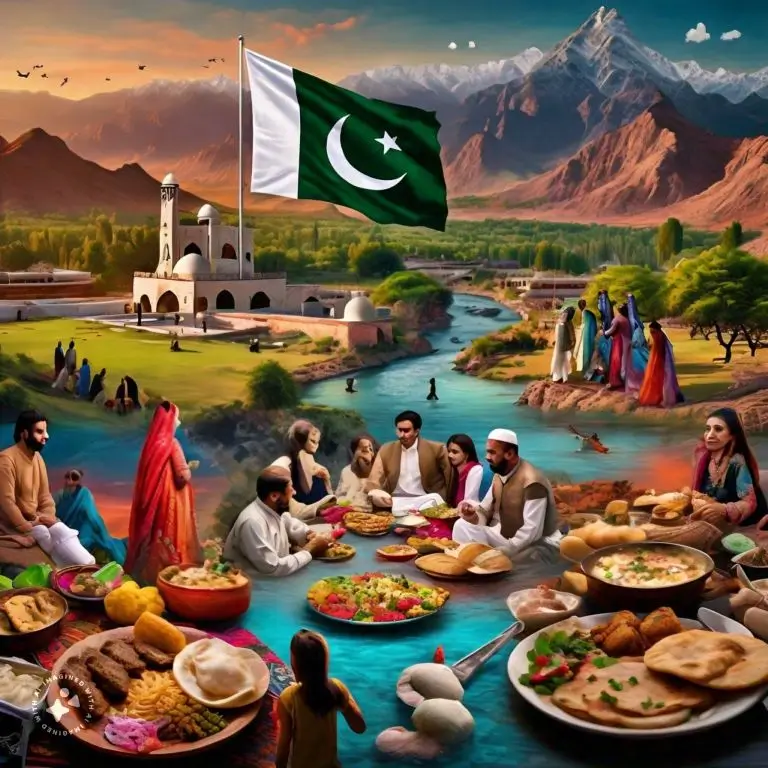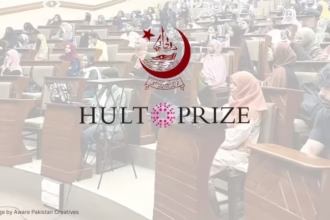Interfaith unity, law and order, and national integration are essential for bringing guaranteed long-term peace and stability to Pakistan. Pakistan is a country with various cultures, races, religions, genders, and languages. We can call Pakistan a land of unity in diversity, where people of different manners, lifestyles, thoughts, norms, and cultures live peacefully together. People from different religions in Pakistan belong to different races, ethnicities, and sects. Regardless of all this, people live together with a special bond of humanity. As Kofi Annan said, “We may have different religions, different languages, and different colored skins, but we all belong to one human race.” National integration and unity are reflected in every aspect of Pakistani culture.
The majority of the population follows the same religion, which leads Muslims to live with minorities in peace and love as prescribed by Islam. Unity in diversity promotes peace and brotherhood among people under the flag of national integration and unity. Unity in Pakistan is the biggest and most unbreakable source of strength for the country. The flag of Pakistan also reflects the culture of unity in diversity, where the green part symbolizes Muslims, the white part symbolizes minorities, and the moon and star represent peace, cooperation, integration, and brotherhood. As Helen Keller said, “Alone, we can do so little; together, we can do so much.”
TYPES OF DIVERSITY IN PAKISTAN:
GEOGRAPHICAL DIVERSITY:
Pakistan is blessed with the most favorable geographic location. We are blessed with all four seasons and have a variety of geographical landscapes, including plains, plateaus, and mountains. Every region has its own unique geographical attractions. If one region has pretty clean beaches, another has giant mountains; if one has five rivers and forests, another has appealing sandy deserts. If one has alluring valleys, another has snow-covered peaks and glaciers. The geography of the region also determines the language, festivals, cuisines, and clothing of the people. Some remarkable regions include the northern area, Koh e Suleman region, Makran region, and Kohistan region.
CULTURAL DIVERSITY:
Cultures evolve and change with the passage of time, and history helps us understand the diversity of culture. Pakistan emerged on the world map 76 years ago, but the history of Pakistani culture is approximately 5000 years old. We find our cultural roots in the era of Aryans and still have remains of the Indus Valley civilization, the migration of Muslims in the region, the Mughal Empire, and British colonialism. Asian culture is collectively known for its family values, respect for elders, and love for children. In our cultural values, we find many customary practices such as hospitality and various practices in weddings, funerals, and other events, which vary in every region and religion. Pakistan is a multicultural country. Foreigners who come to Pakistan are amazed by the vibrant colors of cultures living together. According to Taylor, culture is “that complex whole including beliefs, art, religion, values, norms, ideas, law, thought, knowledge, custom, and other capabilities acquired by a man as a member of society.” We can also define culture as a way of learning, eating, drinking, behaving, walking, working, and dressing. The eating culture, dressing culture, and others vary in every region of Pakistan.
RELIGIOUS DIVERSITY:
The population of Pakistan is diverse in terms of religion. Religion is an essential part of every human’s belief, behavior, and code of conduct. People living in Pakistan are mostly Muslims, as the Islamic Republic of Pakistan was primarily founded for religious considerations. Christianity, Hinduism, Sikhism, and Zoroastrianism are some of the common religions followed by Pakistani people. According to the 2017 census, approximately 96% of the population are Muslims, and approximately 4% are non-Muslims (followers of Christianity, Sikhism, Hinduism, etc.). Due to this religious diversity, we see visible differences in people’s eating and wearing choices.
DIVERSE LANGUAGES OF PAKISTAN:
The number of languages spoken in Pakistan makes it a multilingual country. The national language of Pakistan is Urdu (previously known as Rekhta). Urdu emerged as a language of communication between soldiers and other people, where people of different languages had to find a way to communicate. Urdu is a mixture of languages such as Hindi, Arabic, Persian, Turkish, and Italian. Urdu is widely spoken in Pakistan, while English is also commonly spoken among professionals and is considerable in educational institutes. Regional languages are another aspect that differs in every region and is a cause of unity in diversity. Regional languages transform their dialect, accent, and vocabulary every ten kilometers. There are approximately 77 established languages in Pakistan. Some common regional languages are Punjabi, Pashto, Sindhi, Pothwari, Balochi, Kashmiri, Lasi, Saraiki, Brahvi, and Hindko.
FESTIVALS IN PAKISTAN:
As mentioned, religious diversity influences the festivals celebrated in Pakistan. Muslims celebrate their religious festivals, while minorities also enjoy their religious festivals within the country. Additionally, there are national festivals that everyone in the nation can celebrate. Festivals in Pakistan reflect the country’s diverse culture. Eid-ul-Fitr, Eid-ul-Adha, Shab-e-Barat, Shab-e-Mairaj, Holi, Diwali, Raksha Bandhan, Navratri, Easter, Christmas, and Basant are some of the festivals celebrated in Pakistan. Regional festivals such as Sibi Mela and Kalash Festival, as well as national events like Independence Day, Pakistan Day, and Defense Day, are celebrated all over the country. These festivals promote harmony and unity and reflect the country’s rich traditions and heritage, reminding us of one nation, one body.
THE PAKISTANI CUISINE:
No culture can be fascinating without its distinctive cuisine. The list of popular foods in Pakistan is longer than one might imagine. Food in Pakistan is rich and spicy and varies according to regions, religions, and provinces. Some regions and provinces prefer spicy foods, while others prefer less spicy foods. Religions also influence dietary preferences, such as Muslims eating meat while the Hindu community is mostly vegetarian. Drinks like lassi, sherbet, rabri dodh, sugarcane juice, thadal, doodh patti, and sattu are well-known to every Pakistani. Saag, yakhni pulao, multani sohan halwa, naan paye, and murgh cholay from Punjab; sajji, rosh, and roasted chops from Balochistan; Sindhi biryani, nihari, and fish curry from Sindh; chapli kebab, shinwari karahi, dumpukht, and namkeen gosht from Khyber Pakhtunkhwa can make anyone crave. Pakistani street food, such as tikka boti, shawarma, pakora, bhutta (corn), chola-chat, french fries, dahi bhallay, samosa, falooda, and kulfi, is also mouthwatering and flavorful. The list of food items is extensive and never-ending.
THE PAKISTANI WEARINGS:
A variety of dresses are worn in Pakistan. People in Pakistan take pride in their national dress (shalwar and kameez) for men, and women usually take a dupatta along with this. Each province has its own beautiful variant and style of shalwar kameez. Muslims mostly wear clothes according to their religion, while minorities also wear clothes according to their religions. Elegant, exquisite, and consummate colors and designs, as well as a variety of fabrics such as silk, lawn, cotton, and chiffon, make Pakistani attire unique and wonderful. Punjab is famous for lungi, dhoti, kurta, and khussa; Balochi shalwar, dastaar, and phashik are popular among Baloch people; the famous Sindhi attire includes chunri, lehenga choli, and julaba; sharai, chogha, and kullah are famous Pathani wearings. The enormous white turbans of Balochistan, Sindhi caps, and ajrak shawls from Sindh, khussa and pagri of Punjab, and the famous waistcoat and Pathani topi of the northern areas, as well as the heavy white churis worn by females of Tharparkar, are magnificent and captivating. Every dress has its own unique look and promotes unity among the people.
UNITY AND DIVERSITY AS A WAY TO PROMOTE NATIONAL INTEGRATION OF PAKISTAN:
Accepting diversity is a way to promote national integration. National integration means the acknowledgment and sense of belonging to a common identity among the citizens of a country. National integration plays a vital role in contemporary times in the making of a nation. It keeps the entire country well-connected, organized, and strong, regardless of the diversity of culture, religion, and language. In a country like Pakistan, where people live with such huge diversity and a multi-ethnic, multi-religious, multi-cultural, and multi-lingual society, national integration aims not only to bind and unite people together but also to create a better environment for living in peace and prosperity.
National integration is important in Pakistan; it aims to keep the country stable, helps in the development of the country, promotes loyalty to the country, boosts the feeling of nationalism, unifies countrymen, builds a unified sense of consciousness and belongingness, endorses peace, tolerance, and brotherhood, and increases economic and political stability.
Education, cultural unity, and equity among people are the best ways to promote national integration. Tolerance and respect for each other also promote national integrity. Proper administration and law and order can foster integration among the people of the state. Activities such as exposure visits, talks between people of different diversities on a national level, seminars, and conferences on topics related to national integration can promote unity among countrymen.
As said earlier, national integration is a key concept to unify the nation, but there are also challenges that hinder national integration. These challenges include violence among communities and minorities, provincialism, casteism, narrowness of views and acceptance, political instability (due to lack of good leadership), economic instability and injustice (due to wrong policy decisions), lack of social sense, frustration, and uncertainty among the people. These issues pose significant challenges to national integration in Pakistan. National integration is an important policy goal for many states. Pakistan’s diversity makes it unique, and national integration is crucial for leading the country towards prosperity, development, and the well-being of its people. However, continuous efforts are needed to promote it and address the challenges that hinder integration.
